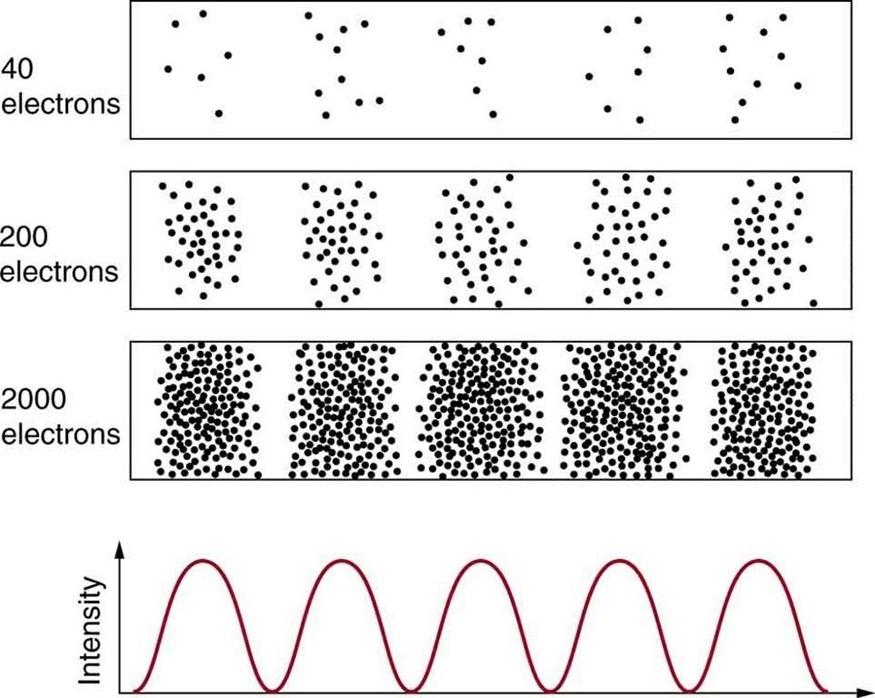Heisenberg Uncertainty
How does knowing which slit the electron passed through change the pattern? The answer is fundamentally important—measurement affects the system being observed. Information can be lost, and in some cases it is impossible to measure two physical quantities simultaneously to exact precision. For example, you can measure the position of a moving electron by scattering light or other electrons from it. Those probes have momentum themselves, and by scattering from the electron, they change its momentum in a manner that loses information. There is a limit to absolute knowledge, even in principle.
It was Werner Heisenberg who first stated this limit to knowledge in 1929 as a result of his work on quantum mechanics and the wave characteristics of all particles. (See Figure 12.25). Specifically, consider simultaneously measuring the position and momentum of an electron (it could be any particle). There is an uncertainty in position that is approximately equal to the wavelength of the particle. That is,
12.40 As discussed above, a wave is not located at one point in space. If the electron’s position is measured repeatedly, a spread in locations will be observed, implying an uncertainty in position . To detect the position of the particle, we must interact with it, such as having it collide with a detector. In the collision, the particle will lose momentum. This change in momentum could be anywhere from close to zero to the total momentum of the particle, . It is not possible to tell how much momentum will be transferred to a detector, and so there is an uncertainty in momentum , too. In fact, the uncertainty in momentum may be as large as the momentum itself, which in equation form means that
12.41 The uncertainty in position can be reduced by using a shorter-wavelength electron, since . But shortening the wavelength increases the uncertainty in momentum, since . Conversely, the uncertainty in momentum can be reduced by using a longer-wavelength electron, but this increases the uncertainty in position. Mathematically, you can express this trade-off by multiplying the uncertainties. The wavelength cancels, leaving
12.42 So if one uncertainty is reduced, the other must increase so that their product is .
With the use of advanced mathematics, Heisenberg showed that the best that can be done in a simultaneous measurement of position and momentum is
12.43 This is known as the Heisenberg uncertainty principle. It is impossible to measure position and momentum simultaneously with uncertainties and that multiply to be less than . Neither uncertainty can be zero. Neither uncertainty can become small without the other becoming large. A small wavelength allows accurate position measurement, but it increases the momentum of the probe to the point that it further disturbs the momentum of a system being measured. For example, if an electron is scattered from an atom and has a wavelength small enough to detect the position of electrons in the atom, its momentum can knock the electrons from their orbits in a manner that loses information about their original motion. It is therefore impossible to follow an electron in its orbit around an atom. If you measure the electron’s position, you will find it in a definite location, but the atom will be disrupted. Repeated measurements on identical atoms will produce interesting probability distributions for electrons around the atom, but they will not produce motion information. The probability distributions are referred to as electron clouds or orbitals. The shapes of these orbitals are often shown in general chemistry texts and are discussed in The Wave Nature of Matter Causes Quantization.
Example 12.8 Heisenberg Uncertainty Principle in Position and Momentum for an Atom
(a) If the position of an electron in an atom is measured to an accuracy of 0.0100 nm, what is the electron’s uncertainty in velocity? (b) If the electron has this velocity, what is its kinetic energy in eV?
Strategy
The uncertainty in position is the accuracy of the measurement, or . Thus the smallest uncertainty in momentum can be calculated using . Once the uncertainty in momentum is found, the uncertainty in velocity can be found from .
Solution for (a)
Using the equals sign in the uncertainty principle to express the minimum uncertainty, we have
12.44 Solving for and substituting known values gives
12.45
Thus,
12.46 Solving for and substituting the mass of an electron gives
12.47
Solution for (b)
Although large, this velocity is not highly relativistic, and so the electron’s kinetic energy is
12.48
Discussion
Since atoms are roughly 0.1 nm in size, knowing the position of an electron to 0.0100 nm localizes it reasonably well inside the atom. This would be like being able to see details one-tenth the size of the atom. But the consequent uncertainty in velocity is large. You certainly could not follow it very well if its velocity is so uncertain. To get a further idea of how large the uncertainty in velocity is, we assumed the velocity of the electron was equal to its uncertainty and found this gave a kinetic energy of 95.5 eV. This is significantly greater than the typical energy difference between levels in atoms (see Table 12.1), so that it is impossible to get a meaningful energy for the electron if we know its position even moderately well.
Why don’t we notice Heisenberg’s uncertainty principle in everyday life? The answer is that Planck’s constant is very small. Thus the lower limit in the uncertainty of measuring the position and momentum of large objects is negligible. We can detect sunlight reflected from Jupiter and follow the planet in its orbit around the sun. The reflected sunlight alters the momentum of Jupiter and creates an uncertainty in its momentum, but this is totally negligible compared with Jupiter’s huge momentum. The correspondence principle tells us that the predictions of quantum mechanics become indistinguishable from classical physics for large objects, which is the case here.



